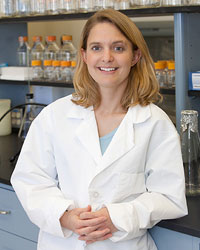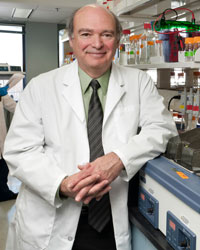Feature Story
Health Center Today, September 29, 2010
Researchers Use Stem Cells to Create Disease Models
By David Bauman

Stormy Chamberlain, assistant professor of genetics and developmental biology at the UConn Health Center.
Photo by Lanny Nagler
UConn researchers have used skin cells from patients with the genetic disorders Angelman Syndrome (AS) and Prader-Willi Syndrome (PWS) to generate induced pluripotent stem (iPS) cells.
Like human embryonic stem (hES) cells, iPS cells can become any cell type in the human body, including brain cells, also known as neurons. Since both of these syndromes have brain abnormalities, neurons were produced from the iPS cells for each of the two diseases so that the root causes could be understood and new therapies developed.
"We are generating individualized stem cells to create in vitro models of human disease," says Marc Lalande, professor of Genetics and Developmental Biology and director of UConnís Stem Cell Institute. "This allows us to investigate diseases such as Angelman and Prader-Willi syndromes by creating stem cells from a patient for studies in a laboratory dish. This type of information is absolutely necessary to improve our ability not only to understand and treat these two syndromes but also other human conditions with intellectual disabilities or seizures or abnormal feeding behavior."
This study is published in the September 27 edition of the Proceedings of the National Academy of Sciences.
People with AS have profound intellectual disabilities, lack of speech, seizures, hand flapping, and motor and balance disorders. ďPatients with Angelman Syndrome live full lives, which means they are in constant need of caregivers,Ē says Stormy Chamberlain, an assistant professor of genetics and developmental biology at the UConn Health Center.
Children with PWS suffer early postnatal feeding difficulties and poor muscle tone, but later develop an insatiable appetite and uncontrollable eating, which results in severe obesity that begins during early childhood. PWS individuals also have behavioral problems that are similar to obsessive-compulsive disorder. Due to their obsession with food, people with PWS often live in specialized group homes, where food cabinets and refrigerators are kept tightly locked.
"Prader-Willi Syndrome is a cruel disorder because in addition to the extreme food compulsion, the patients also burn fewer calories, making weight control for these individuals particularly difficult," notes Chamberlain.
Angelman and Prader-Willi syndromes are caused by an abnormal chromosome 15. Humans typically have 23 pairs of chromosomes Ė one member of each pair is inherited from the mother, while the other member is inherited from the father, to convey hereditary traits that parents pass to their offspring.

Marc Lalande, professor of Genetics and Developmental Biology and director of UConnís Stem Cell Institute.
Photo by Lanny Nagler
Lalande discovered more than 20 years ago that cells keep track of which parent passes on each chromosome 15. PWS occurs when an abnormal copy of chromosome 15 is inherited from the father, while AS is caused by an abnormal chromosome 15 inherited from the mother.
"We know that the patientsí skin cells remember which chromosome 15 was inherited from the father and which one was inherited from the mother, but we didnít know whether this memory would be erased upon reprogramming the skin cells as stem cells," says Chamberlain, who leads the research team that generated the new stem cell lines. "We were surprised to find that the stem cells remember from which parent they were inherited perfectly!"
This was surprising because the process of reprogramming skin cells involves erasure of the cellís memory of being a skin cell and resetting it to the memory of a stem cell. If the memory of parental origin of chromosome 15 were erased, it would mean that the iPS cells could not be used to make working stem cell models of the two syndromes.
To generate the iPS cell lines, the UConn research team inserted a cocktail of genes into skin cells taken from the patients to trigger a process that reprogrammed the skin cell to an embryonic-like or pluripotent state and then coaxed them into becoming neurons.
"With live neurons in a dish, we can study what is wrong with the cells that make up the brains of kids with these disorders," Chamberlain says. "The ultimate goal, is to take the neurons, figure out whatís wrong with them, and develop drugs that can fix that defect."
Chamberlain speculates that Angelman and Prader-Willi syndromes are not likely to be repaired by cell replacement therapy, like some other disease: "In our case we think that the stem cell-derived neurons can be better used to study the disease and design drugs for these disorders."
This study was funded by the Connecticut State Stem Cell Research Fund, the Raymond and Beverly Sackler Foundation, and the Foundation for Prader-Willi Syndrome Research.


